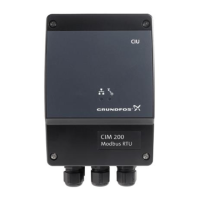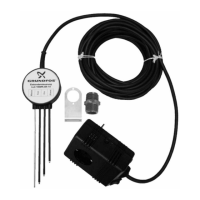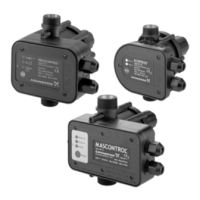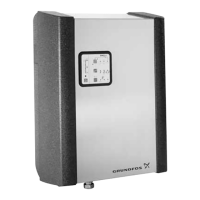From 12:31 to the next time, the set-point will be 55 psi. The
next time is at 6:30 am, which was the first entry.
202 - Set-point Influence
Several different displays may appear under “setp. influ-
ence” depending on the influence type selected.
[Progressive infl] “System Friction Compensation:”
“Progressive influences” is a system friction compensation
factor which can provide a constant pressure at a down-
stream location as flow demand changes, regardless of
pipe friction loss. For example, although the pressure at
the sensor on the discharge manifold will remain constant
as flow increases (when “progressive infl.” is not selected),
friction losses in the system piping will cause increasing
pressure drops below the set-point at locations down-
stream from your BoosterpaQ. If you want to maintain
stable pressure at a critical pressure point some distance
from the sensor without moving the sensor (maybe you
would have to bore through concrete or a mountain to
do so), your BoosterpaQ can adjust the set-point to com-
pensate for the system friction losses as flow increases.
The pressure at the sensor will now follow the changing
set-point and the system friction losses will drop this
changing set-point output down to the desired set-point
at the critical location. You must know your system friction
characteristics (plot a system curve using standard tables).
It can also be set by “trial and error.”
To activate progressive infl., set “progressive infl.” [on]
(Display 202). The pressure will rise at the manifold pres-
sure sensor as flow increases. The flow is estimated accord-
ing to PMU 2000 internal operating data without actual
measurement of the flow, eliminating the high cost of a
flow meter. “Set-point act.” will increase linearly from the
adjustable percentage at zero flow to 100% of “set-point
max.” at maximum flow. “Maximum flow” is the sum of
the maximum flows of all the pumps in the zone, minus all
standby pumps (see “Standby Pumps,” Display 226).
To calculate what
“set-point max.”
must be when
“progressive infl.”
is active, calculate
the system friction
drop between the
BoosterpaQ and
the critical pressure
point at maximum
flow. Add this value
to the desired set-
point at the critical pressure point. This is “set-point max.”.
Now divide the desired set-point at the downstream
critical point by the sum of the friction loss and the desired
set-point and express the result as a percentage. To active
“progressive infl.,” select [on] in Display 202 and advance
to the next display (press “Enter”). Enter the percentage
value you calculated. The setting range is 50% to 100%.
Example for Setting the Set-point Influence:
A system pressure (set-point max) of 90 psi is required at
full flow. It has been determined that at low flow a system
pressure of 70 psi will be sufficient.
First of all the progressive influence needs to be switched
“on”. Once this is done the PMU display should look like
the following:
Set A setp. influence
progressive infl _on
Next press the down arrow and you will see the following
screen: The first number (50 in this case) is the percentage
of set-point max the discharge pressure will be at zero
flow.
Set A setp. influence
progressive _ 50 -> 100%
In this example the desired pressure at zero flow is 70 psi
which is 78% (70/90 = 0.78) of the set-point max. So the
final entry should look like the following:
Set A setp. influence
progressive _ 78 -> 100%
As flow increases the discharge pressure will progressively
increase as the flow approaches 100% (all pumps on at
100%).
204 - System Time Constant (Reaction Time)
The time constant determines the reaction time of the
system to changing demands and changed set-points. The
time constant is defined as the time which passes between
when an adjustment is made until the actual value has
moved approximately 70% of the distance between the
starting value and the new adjusted value. Entering the
system time into the PMU 2000 allows it to adjust its reac-
tion time to match the system characteristics, reducing the
possibility of “overshoot” (actual pressure shooting past
the desired point, high or low, because the pump system
responds too quickly) and sluggish performance.
High value means a slow system; therefore slow
reaction is required (for example: “temperature
change”)
Low value means a fast system; therefore, fast
reaction is required (for example: pressure
usually changes fast)
The selection range is 0.4 - 800 seconds. The normal range
is 0.4 to 5.0 seconds (default = 2 seconds). The default
value on BoosterpaQ systems is set low as most pres-
sure systems are fairly fast. Calculating system time can
be difficult for fast changing systems, so “trial and error”
is usually applied and is acceptable. Slower systems can
more easily be tested and measured, so calculation is pos-
sible. For example, if you have set up your BoosterpaQ for
maintaining a set temperature, you can set the system
time to 0.4, change the set-point, measure the time it
takes to change the temperature from the starting point
to the new set-point, and multiply by 0.7 to get the system
time constant.
Example of friction
loss compensation
26
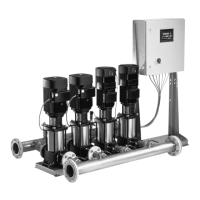
